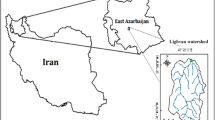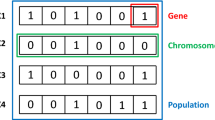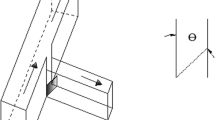Abstract
The integrated hydrological modeling techniques were used to create a conceptual rainfall-runoff model for Hurman River watershed. The HEC-HMS and water modeling system (WMS) were used to generate the required runoff data at any location within the watershed based on the flow duration curve (FDC) analysis. The modeling results showed a good agreement between the observed and the simulated runoff data. The model accuracy was confirmed through four well statistical indicators, Nash–Sutcliffe efficiency (NSE), coefficient of determination (R2), mean error (ME) and root mean square error (RMSE). The watershed was divided into 130 sub-basins by adding outlet at each 1 km distance along the stream network and runoff was simulated by using daily rainfall data. The 130 flow duration curves were estimated. Gene expression programming was used to develop a mathematical expression based on the results of rainfall-runoff model to generate flow duration curve at any location along the stream network. A Visual Basic Computer Program was developed with visual interface in Microsoft Excel software to run-of-the river type hydropower plant site assessment. A searching algorithm to select optimum site to install the hydropower project was developed according to the power or head criteria. The results showed that 1 MW as input power criteria revealed optimum hydroelectricity generation compared to other alternative design criteria.






Similar content being viewed by others
References
Aytek A, Kisi O, Guven A (2014) A genetic programming technique for lake level modeling. Hydrol Res 45(4–5):529–539
Azamathulla HM (2012) Gene expression programming for prediction of scour depth downstream of sills. J Hydrol 460–461:169–172
Azamathulla HM, Jarrett RD (2013) Use of gene-expression programming to estimate Manning’s Roufgness Coefficent for high gradient streams. Water Resour Manag 27:715–729
Azamathulla HM, Ghani AA, Leow CS, Chang CK, Zakaria NA (2011) Gene-expression programming for the development of a stage discharge curve of the Pahang river. Water Resour Manag 25:2901–2916
Booker D, Snelder T (2012) Comparing methods for estimating flow duration curves at ungauged sites. J Hydrol 434:78–94
Coskun HG, Alganci U, Eris E, Agıralioglu N, Cigizoglu HK, Yilmaz LZ, Toprak ZF (2010) Remote sensing and GIS innovation with hydrologic modelling for hydroelectric power plant (HPP) in poorly gauged basins. Water Resour Manag 24:3757–3772
Ferreira C (2001) Gene expression programming: a new adaptive algorithm for solving problems. Complex Syst 13(2):7–129
Ferreira C (2006) Gene expression programming: mathematical modeling by an artificial intelligence, 2nd edn. Springer, Berlin (DE)
García A, Sainz A, Revilla J, Álvarez C, Juanes J, Puente A (2008) Surface water resources assessment in scarcely gauged basins in the north of Spain. J Hydrol 356:312–326
Guven A (2009) Linear genetic programming for time-series modeling of daily flow rate. J Earth Syst 118(2):137–146
Guven A, Kisi O (2011) Estimation of suspended sediment yield in natural rivers using machine-coded linear genetic programming. Water Resour Manag 25:691–704
Halwatura D, Najim M (2013) Application of the HEC-HMS model for runoff simulation in a tropical Catchment. Environ Model Softw 46:155–162
Karbasi M, Azamathulla HM (2015) GEP to predict characteristics of a hydraulic jump over a rough bed. KSCE J Civ Eng. doi:10.1007/s12205-016-0821-x
Kisi O, Guven A (2010) A machine code-based genetic programming for suspended sediment concentration estimation. Adv Eng Softw 41(7–8):939–945
Kisi O, Emiroğlu ME, Bilhan O, Guven A (2012) Prediction of lateral outflow over triangular labyrinth side weirs under subcritical conditions using soft computing approaches. Expert Syst Appl 39(3):3454–3460
Kusrea BC, Baruah DC, Bordoloi PK, Patra SC (2010) Assessment of hydropower potential using GIS and hydrological modeling technique in Kopili River basin in Assam (India). Appl Energy 1:298–309
Laouachria F, Mansouri R (2015) Comparison of WBNM and HEC-HMS for runoff hydrograph prediction in a small urban catchment. Water Resour Manag 29:2485–2501
Lins C, Laguna M (2005) Runway potential: small hydro in Europe and beyond. Renew Energy World 37(2):248–253
Liucci L, Valigi D, Casadei S (2014) A new application of flow duration curve (FDC) in designing run-of-river power plants. Water Resour Manag 28:881–895
Longobardi A, Villani P (2013) A statistical, parsimonious, empirical framework for regional flow duration curve shape prediction in high permeability Mediterranean region. J Hydrol 507:174–185
Mehr AD, Kahya E, Olyaie E (2013) Streamflow predication using linear genetic programming in comparison with a neuro-wavelet technique. J Hydrol 505:240–249
Mehr A, Kahya E, Yerdelem C (2014) Linear genetic programming application for successive-station monthly streamflow predication. Comput Geosci 70:63–72
Melikoglu M (2013) Hydropower in turkey: analysis in the view of vision 2023. Renew Sust Energ Rev 25:503–510
Mendicino G, Senatore A (2013) Evaluation of parametric and statistical approaches for the regionalization of flow duration curves in intermittent regimes. J Hydrol 480:19–32
Niadas A (2005) Regional flow duration curve estimation in small ungauged catchments using instantaneous flow measurements and a censored data approach. J Hydrol 314:48–66
Oleyiblo J, Li Z (2010) Application of HEC-HMS for flood forecasting in Misai and Wan’an catchments in China. Water Sci Eng 3:14–22
Pandey A, Lalrempuia D, Jain SK (2015) Assessment of hydropower potential using spatial technology and SWAT modelling in the Mat River, southern Mizoram, India. Hydrol Sci J 60(10):1651–1665
Punys P, Dumbrauskas A, Kavraciejus A, Vyciene G (2011) Tools for small hydropower plant resources planning and development: a review of technology and applications. Energies 4:1258–1277
Rojanamon P, Chaisomphob T, Bureekul T (2009) Application of geographical information system to site selection of small run-of-river hydropower project by considering engineering/economic/environmental criteria and social impact. Renew Sust Energ Rev 13:2336–2348
Seckin N, Guven A (2012) Estimation of peak flood discharges at ungauged sites across turkey. Water Resour Manag 26:2569–2581
Shresta S, Khatiwada M, Babel MS, Parajuli K (2014) Impact of climate change on river flow and hydropower production in Kulekhani hydropower project of Nepal. Environ Process 1(3):231–250
Soil Conservation Service (1986) Urban hydrology for small watershed. Technical releases 55, 2nd edn. U.S. Dept. of Agriculture, Washington D.C
Tofiq F, Guven A (2014) Prediction of design flood discharge by statistical downscaling and General Circulation Models. J Hydrol 517:1145–1153
Traore S, Guven A (2013) New algebraic formulations of evapotranspiration extracted from gene-expression programming in the tropical seasonally dry regions of West Africa. Irrig Sci 31:1–10
US Army Corps of Engineers (2000) Hydrologic modeling system HEC-HMS technical reference manual. Hydrologic Engineering Center, Davis, CA
Yi C, Lee J, Shim M (2010) Site location analysis for small hydropower using geo-spatial information system. Renew Energy 35:852–886
Zorn CR, Shameldin AY (2015) Peak flood estimation using gene expression programming. J Hydrol 531:1122–1128
Author information
Authors and Affiliations
Corresponding author
Rights and permissions
About this article
Cite this article
Al-Juboori, A.M., Guven, A. Hydropower Plant Site Assessment by Integrated Hydrological Modeling, Gene Expression Programming and Visual Basic Programming. Water Resour Manage 30, 2517–2530 (2016). https://doi.org/10.1007/s11269-016-1300-3
Received:
Accepted:
Published:
Issue Date:
DOI: https://doi.org/10.1007/s11269-016-1300-3




